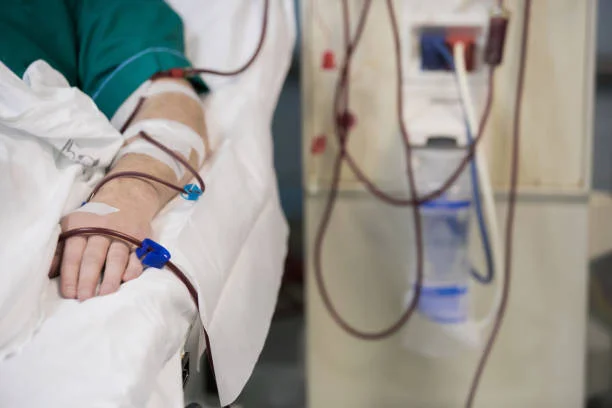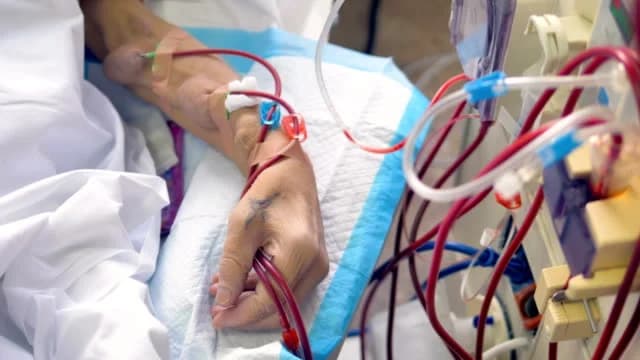Dialysis is one way to manage kidney failure. Dialysis has 2 types, hemodialysis, and peritoneal dialysis, which both perform normal kidney functions, filtering waste and excess fluid from the blood.
Who needs dialysis?
People who havekidney failure, or end-stage renal disease (ESRD), may need dialysis. Also, injuries and conditions such as high blood pressure, diabetes, and lupus can damage kidneys, leading to kidney disease. Kidney failure can happen over time or come on suddenly (acute) after a severe illness or injury. Acute kidney failure could go away as you recover. Kidney disease has 5 stages. If you are at stage 5, you may be experiencing end-stage renal disease (ESRD) or kidney failure. At this point, kidneys are carrying out around 10% to 15% of their normal function. You may need dialysis or a kidney transplant to stay alive. Some people undergo dialysis while waiting for a transplant.

When should I see a doctor?
In case you are experiencing these below, you should call your doctor:
Difficulty urinating
Dizziness, fainting, unusual thirst (dehydration), or other signs of low blood pressure
Nausea and vomiting
Signs of infection, such as fever or oozing and redness at the AV fistula or catheter site
Severe abdominal pain
The unusual bulge in the abdomen or groin (hernia)
The Dialysis Process
Dialysis is a medical procedure that performs the function of the kidneys when they are no longer able to do so. It removes waste products and excess fluid from the blood, which are normally eliminated by the kidneys. There are two main types of dialysis: hemodialysis and peritoneal dialysis.
Hemodialysis
The most common type of dialysis. In this process, blood is pumped out of your body to an artificial kidney machine, and returned to your body by tubes that connect you to the machine. Hemodialysis is usually performed at a dialysis center three times per week, with each session lasting about four hours.
During hemodialysis, your blood travels through tubes from your body into the dialysis machine, which contains a dialyzer or artificial kidney. Inside the dialyzer, blood is filtered through a semi-permeable membrane, which allows waste products and excess fluid to pass through, but retains the blood cells and protein. The cleaned blood is then returned to your body.
Peritoneal dialysis
This type, uses the lining of your abdominal cavity, or peritoneum, as the filter. A catheter is surgically placed in your abdomen. During treatment, a special fluid called dialysate is flowed into the abdomen. Waste products and excess fluid are drawn out of your blood and into the dialysate, which is then drained from your abdomen.

Preparing for Treatment
Dialysis treatment is a life-saving procedure for individuals with kidney failure, but preparing for it requires careful planning and adjustments in various aspects of life. Preparing for dialysis involves a combination of physical, dietary, emotional, and lifestyle adjustments, including:
Patients will need a minor surgical procedure to create a vascular access point for the dialysis machine. This could be an arteriovenous (AV) fistula, AV graft, or a venous catheter, depending on your specific health condition.
Dietary changes are often necessary when preparing for dialysis. Since the kidneys are responsible for filtering waste products from your blood, their failure means certain substances can build up to harmful levels. Therefore, you may need to limit your intake of potassium, phosphorus, and sodium.
Fluid intake may also need to be restricted, as damaged kidneys can’t remove excess fluid efficiently. This can lead to swelling, high blood pressure, and other complications.
Physical preparation also involves maintaining a healthy weight and staying active. Regular exercise can help manage symptoms of kidney disease and improve your overall health.
Medications are a crucial part of treatment for kidney disease and preparation for dialysis. You may need to take several different medications to manage symptoms, control blood pressure, and correct anemia or other blood-related issues.
Emotionally, preparing for dialysis can be challenging. It’s normal to experience a range of emotions, from fear and anxiety to frustration or depression.
On the day of your dialysis treatment, wear comfortable clothing and bring activities to keep you occupied during the procedure, which can take several hours.
Regular check-ups and open communication with your healthcare team are vital. They can monitor your condition, adjust your treatment plan as necessary, and address any concerns or questions you may have.
What are the risks associated with dialysis?
While all forms of dialysis can save your life, they also carry certain risks.
Risks associated with hemodialysis
Low blood pressure
Anemia, or not having enough red blood cells
Muscle cramping
Difficulty sleeping
Itching
High blood potassium levels
Pericarditis is an inflammation of the membrane around the heart
Sepsis
Bacteremia, or a bloodstream infection
Irregular heartbeat
Sudden cardiac death, is the leading cause of death in people undergoing dialysis
Risks associated with peritoneal dialysis
Peritoneal dialysis is associated with an increased risk for infections in or around the catheter site in the abdominal cavity. Other risks include:
Abdominal muscle weakening
High blood sugar due to the dextrose in the dialysate
Weight gain
Hernia
Fever
Stomach pain

How is life on dialysis?
Many people on dialysis have a good quality of life. If you're otherwise well, you should be able to:
Continue working or studying
Drive
Exercise
Go swimming
Go on holiday
Many patients can remain on dialysis for many years, although the treatment can only partially compensate for the loss of kidney function. When your kidneys don't work properly there is a significant strain on your body, which means people can die while on dialysis if they don't receive a kidney transplant. Especially older patients and those with other health problems.
What if I want to stop dialysis?
Dialysis should help maintain or improve your quality of life, but if you choose to stop it at any time, you can talk to your doctor about other treatment options. Changes to your diet or lifestyle may improve your quality of life.
Conclusions
In conclusion, dialysis is a life-saving treatment for patients with kidney failure. It performs the function of the kidneys, removing waste products and excess fluid from the body. While it can be a challenging process for patients, advancements in technology have made it more efficient and comfortable. However, it is not a cure for kidney disease. The ultimate goal remains to prevent kidney disease through early detection and treatment of its underlying causes. Despite the challenges, dialysis provides patients with kidney failure the ability to lead active and fulfilling lives.